The company is best known for producing the Star Wars and Indiana Jones films, but it has produced other box-office hits. It has also been a leader in developing new film technology in special effects, sound design, computer animation, and various additional fields, through its subsidiaries that include Industrial Light & Magic, Skywalker Sound, and Lucasfilm Animation. Due to their expertise, its subsidiaries often assist in the production of non-Lucasfilm pictures.
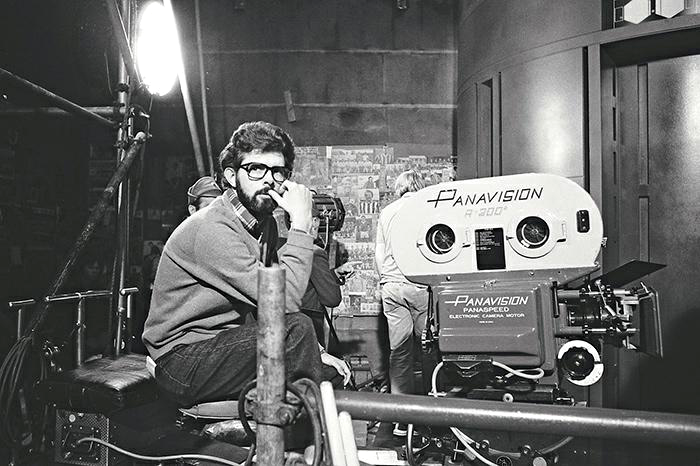
George Lucas, the founder of Lucasfilm and creator of Star Wars.
Lucasfilm was founded as an independent production company by George Lucas in 1971 to maintain creative control over his films following his fraught experiences with Hollywood studios while producing THX 1138. The company's first production was American Graffiti, which was distributed by Universal Pictures and grossed US$55 million in rentals.
During the production of Star Wars: Episode IV A New Hope, Lucasfilm established a special effects shop near Van Nuys Airport in Los Angeles, which later became the Lucasfilm subsidiary Industrial Light & Magic (ILM). The first Star Wars film was released on May 25, 1977 and became a box office success, grossing US$307,263,857. In addition, Lucasfilm entered into merchandising agreements with several companies, including Kenner Products, Image Factory, and Marvel Comics for Star Wars-related clothes, posters, toys, buttons, decals, and comics. Using the money trickling from Lucasfilm's merchandising, Lucas established an office at a Lankershim Boulevard property called called "The Egg Company", with the help of the company's first CEO Charlie Weber.
20th Century Fox was the original copyright owner of A New Hope and the merchandising rights were split between them and Lucas 60/40. Lucasfilm gained all the Star Wars IP and licensing rights held by Fox, excluding A New Hopes copyright, on September 1, 1981. A New Hopes copyright was eventually transferred to Lucasfilm on January 18, 1997.
In late 1977, Lucas established a subsidiary called "The Chapter II Company" to oversee production and funding of Star Wars: Episode V The Empire Strikes Back. In addition, Lucas relocated ILM from Los Angeles to San Francisco. Lucas later purchased a ranch in Marin County near San Francisco which became Skywalker Ranch. While working on The Empire Strikes Back, Lucasfilm also produced a Star Wars spinoff film called The Star Wars Holiday Special, which was distributed by CBS on November 17, 1978. The Empire Strikes Back was released on May 21, 1980, becoming a box office success and grossing nearly US$210 million during its first run.
Charlie Weber also served as the first CEO of Lucasfilm but left following the release of The Empire Strikes Back due to differences with Lucas. While Lucas wanted to focus on building Skywalker Ranch, making Star Wars: Episode VI Return of the Jedi, and creating a filmmaker's community, Weber wanted Lucasfilm to diversify into other businesses. Lucas dismissed Weber and promoted as Lucasfilm's new CEO. Following the release of The Empire Strikes Back, Lucasfilm closed down The Egg Company and relocated all its operations to Skywalker Ranch.
Lucasfilm produced the third Star Wars film Return of the Jedi, which was released on May 25, 1983 and grossed US$250 million by the end of the year. Besides Return of the Jedi, Lucasfilm also produced Raiders of the Lost Ark and (1981) and Indiana Jones and the Temple of Doom (1984), which were distributed by Paramount Studios and also performed well at the box office.
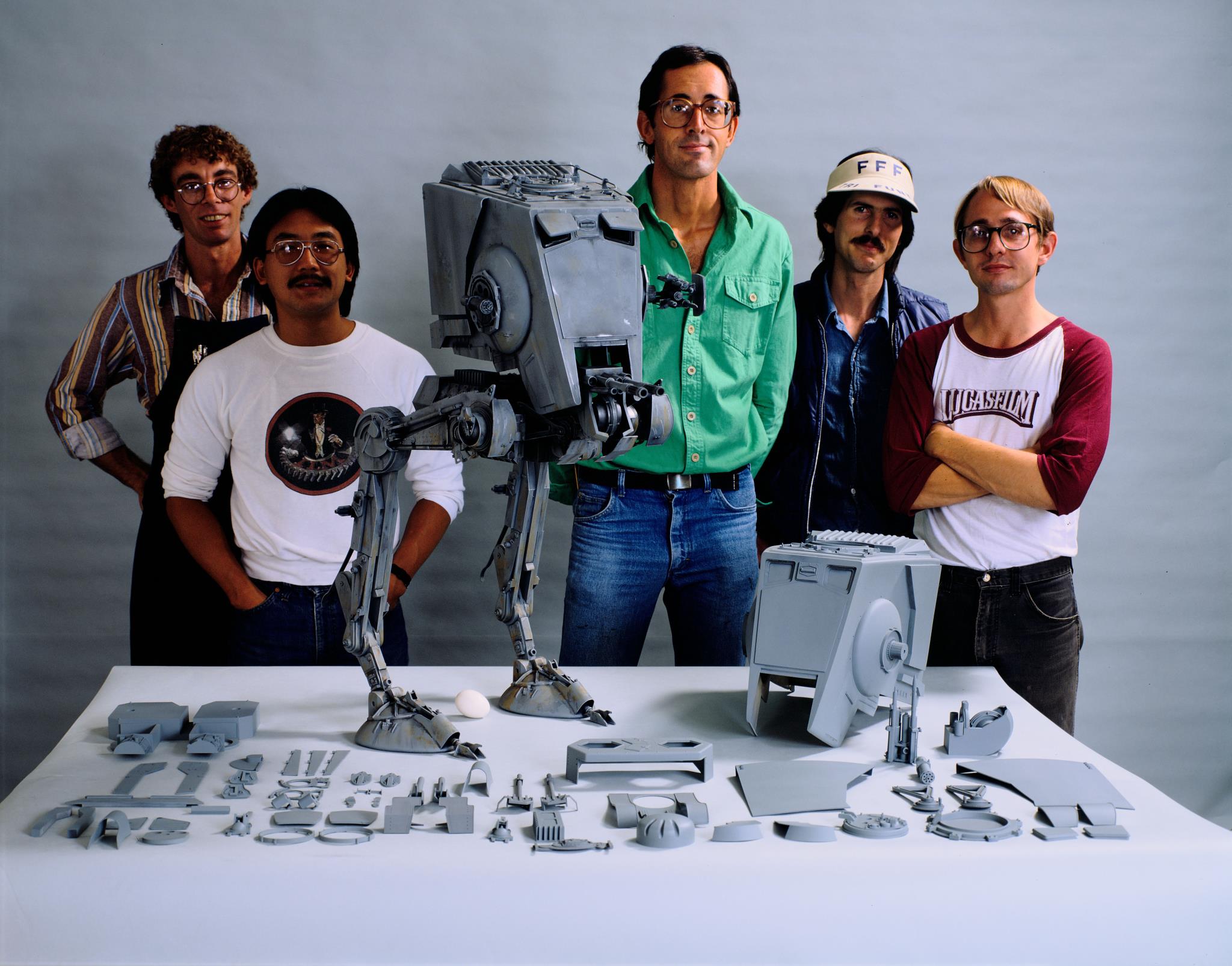
Members of the Industrial Light & Magic team with an AT-ST walker model
During the 1980s, Lucas also opened ILM to producing special effects for non–Lucasfilm projects. The first of these non–Lucasfilm projects was the joint Paramount–Disney 1981 film Dragonslayer. Other notable films that ILM worked on included Star Trek II: The Wrath of Khan, The Abyss (1989), Terminator, and Jurassic Park. ILM became the preeminent special effects shop, winning the Academy Awards for Best Visual Effects thirteen times.
Using Star Wars merchandising revenue, Lucas continue to expand Skywalker Ranch. He envisioned Lucasfilm as a "one-stop, full service" company for other filmmakers. These services included providing writing retreats for screenwriters, editing equipment to film editors, and special effects services via ILM. During the 1980s, Lucas also invested in another Lucasfilm start-up called THX, which focused on improving cinema theatres' sound quality using Lucas' THX sound system.
Lucas also established a computer game division at Lucasfilm and with the help of Edwin Catmull recruited Peter Langston to head that division. The Lucasfilm Games Group (which later became LucasArts) cut a deal with the video game company Atri to produce two non-Star Wars games called Ballblazer (1984) and Rescue on Fractalus!. After Atari encountered financial troubles, Lucasfilm entered into an agreement with video game publisher Epyx to produce two games in 1985. In February 1986, Lucas sold Lucasfilm's computer graphics group and their Pixar computer to Apple co-founder Steve Jobs, who turned the division into a profitable animated film studio called Pixar.
In 1987, Howard Roffman, the new Vice President of Lucas Licensing, was tasked with reviving Lucasfilm's toy line, which had dropped to US$35 million by 1985. Under Roffman and Lucas's leadership, Lucasfilm produced and collaborated on several non-Star Wars films including Howard the Duck (1986), Labyrinth (1986), Willow (1988), Tucker: The Man and His Dream (1988), the third Indiana Jones film Indiana Jones and the Last Crusade (1989), the Radioland Murders (1994), and The Young Indiana Jones Chronicles (1992-1993).
Besides cinematic films, Lucasfilm also worked with Disney to developed a Star Wars–themed simulated ride at their Disney parks called Star Tours and a 3-D movie featuring popstar Michael Jackson called Captain EO. During the 1990s, Lucas also worked with Apple Inc., National Geographic, the Smithsonian Institution, and the National Audubon Society to produce several educational media including GTV: A Geographic Perspective on American History, Life Story: The Race for the Double Helix, and Mystery of the Disappearing Ducks.
During the 1990s, Lucas expanded Skywalker Ranch to nearly 5,000 acres to accommodate more office space at the adjacent Big Rock Ranch. However, Lucasfilm was unable to relocate ILM from San Rafael due to opposition from Marin County residents. Hal Barwood also joined LucasArts in 1990. Under Barwood's leadership, the subsidiary produced several computer games including Indiana Jones and the Fate of Atlantis, Monkey Island, and Grim Fandango.
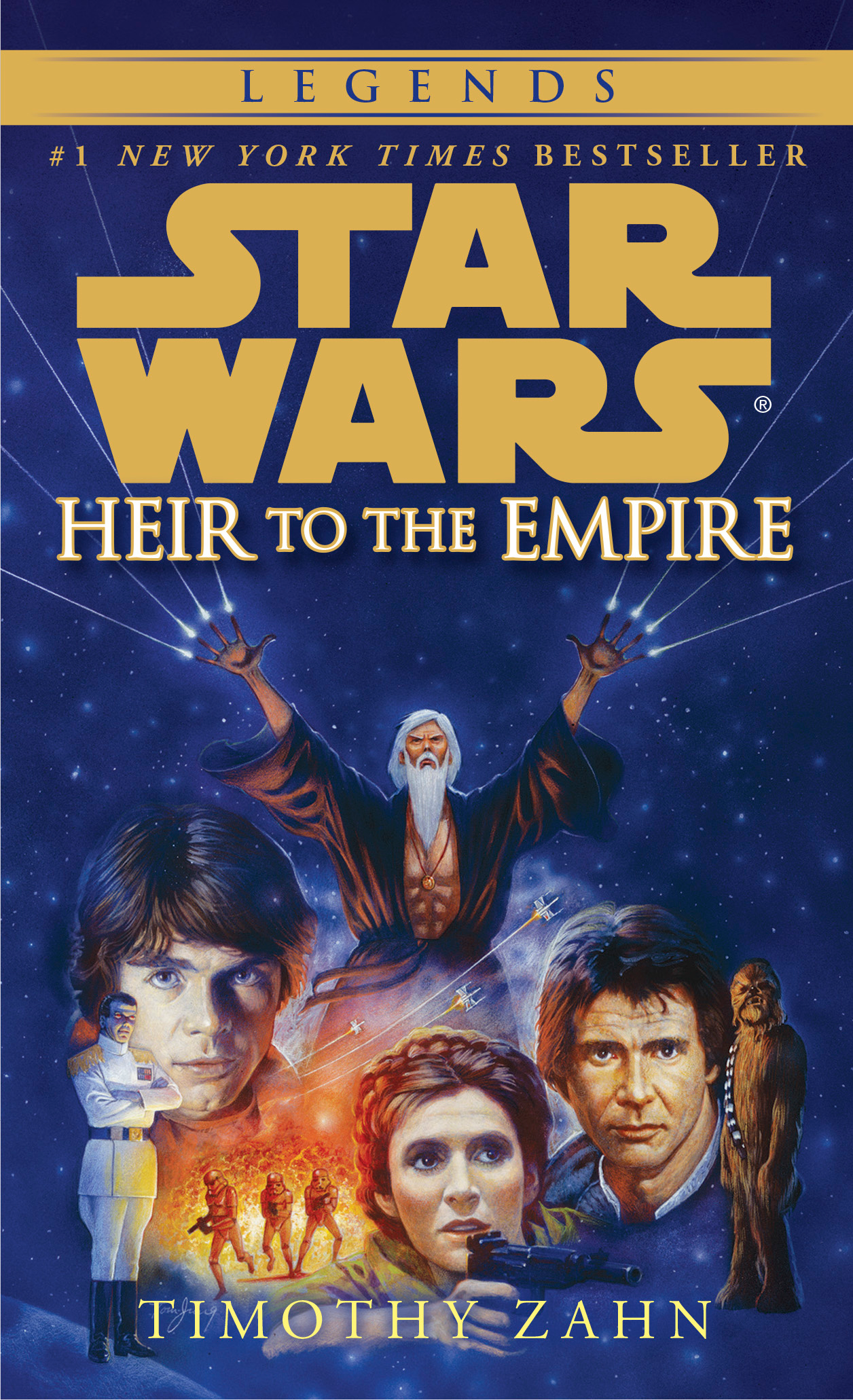
Lucas allowed various authors and creators to produced licensed Star Wars works including Timothy Zahn's Heir to the Empire.
Following the release of The Return of the Jedi, Lucasfilm worked on several Star Wars– television productions including the 1984 television movie Caravan of Courage: An Ewok Adventure, the 1985 sequel film Ewoks: The Battle for Endor, and the cartoon series Star Wars: Droids: The Adventures of R2-D2 and C-3PO and Ewoks, which were distributed by ABC Television. Produced by Nelvana animation studio, Droids and Ewoks were intended to generate a toy merchandising line. However, the two animated series did not perform well commercially with Ewoks being canceled after two seasons and Droids after one season.
In May 1987, Lucasfilm hosted the first Star Wars convention at a hotel near Los Angeles, which attracted 10,000 events. Lucas himself attended the event, accompanied by the Star Wars characters R2-D2 and C-3PO and Star Trek creator Gene Roddenberry. That same year, Lucasfilm launched a fan magazine called the Lucasfilm Fan Club magazine. In October 1987, Lucasfilm also licensed Star Wars role playing games to the start-up West End Games, which helped expanded the Star Wars Expanded Universe by creating new alien species, ships, weapons, and droids. Until 1990, West End Games' Star Wars role playing games were the only Star Wars stories being produced.
In 1988, Lou Aronica, the-then head of mass market publishing at Bantam Books convinced Lucas and Lucas Licensing Vice President Howard Roffman to license a series of Star Wars novels set following the events of Return of the Jedi. The first of these novels was Timothy Zahn's Heir to the Empire (1991), which became a bestseller and spawned two sequels. The successful Thrawn Trilogy led to a line of Expanded Universe novels, which were produced under the Bantam Spectra imprint.
During the 1990s, Lucasfilm entered into a licensing agreement with Dark Horse Comics, beginning with the 1991 comic Star Wars: Dark Empire. Beginning in 1993, the company also entered into licensing agreements with Nintendo to produce Star Wars computer games, trading chards, and bendable figures. In 1995, Hasbro Inc. produced a new line of Star Wars toys under the imprint "The Power of the Force." In 1997, Lucasfilm released the commerciallyThe Star Wars Trilogy Special Edition, which inserted digitally added characters and creatures into existing scenes.
In 1998, Del Rey acquired the Lucasfilm publishing license from Bantam Spectra as part of a publishing deal connected to the upcoming Prequel trilogy. The following year, Del Rey launched a new line of Star Wars Expanded Universe novels known as the New Jedi Order series, which introduced the extragalactic Yuuzhan Vong as antagonists.
By the early 21st century, the Expanded Universe had spawned numerous licensed novels, comics, and computer games including the Tales of the Jedi comics, BioWare's Star Wars: Knights of the Old Republic computer game, and the online role playing game Star Wars: The Old Republic. To maintain consistency between the various stories, Lucasfilm created an internal database known as the Holocron continuity database, which lists the various Star Wars characters, planets, ships, and concepts. This database is still maintained by Lucasfilm employee Leland Chee.
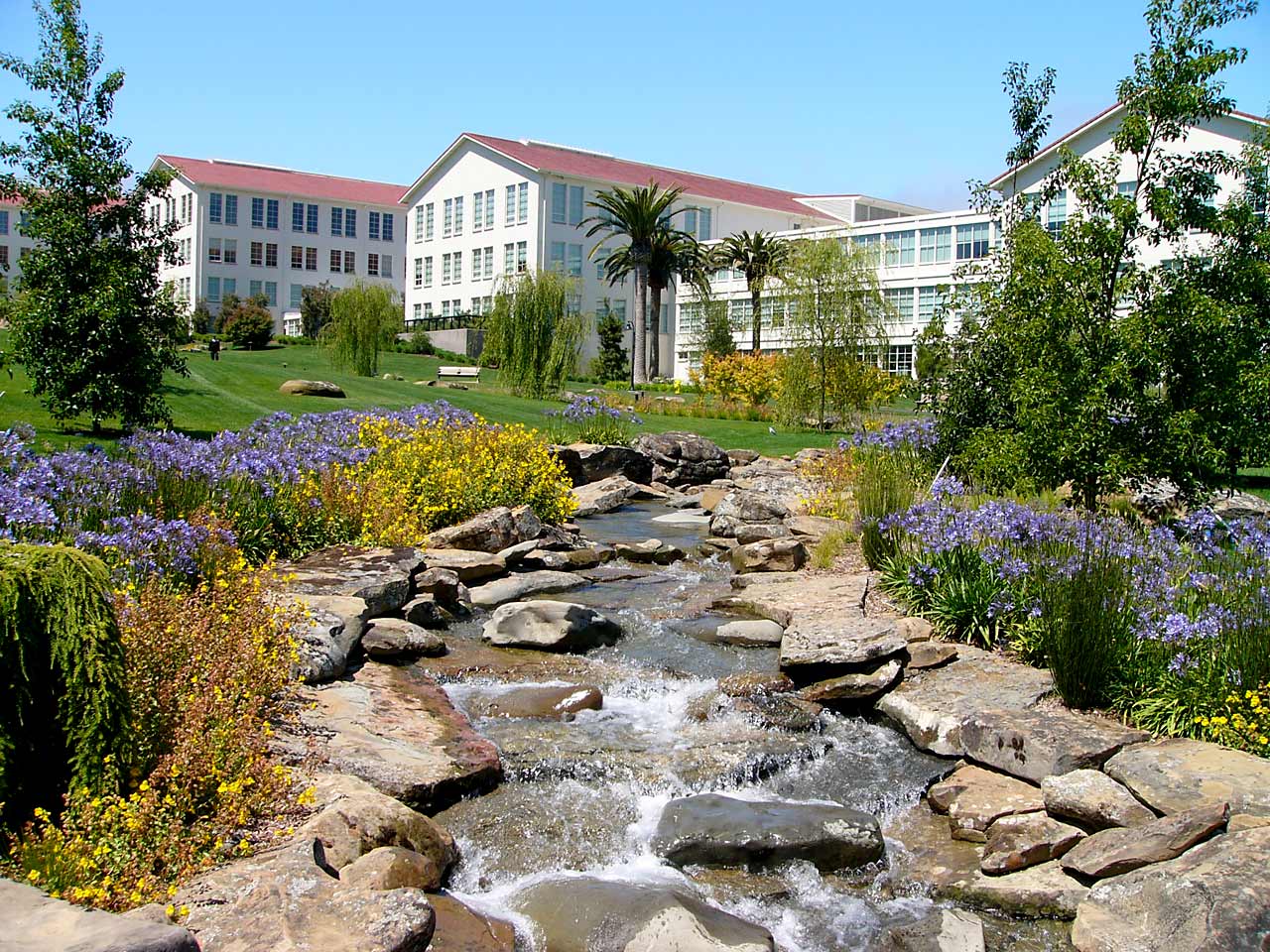
Lucasfilm's present headquarters, the Letterman Digital Arts Center
Lucas began work on the script for Star Wars: Episode I The Phantom Menace on November 1, 1994. The film premiered on May 19, 1999, grossing a total of US$926 million by the end of the year. The film's sequel Star Wars: Episode II Attack of the Clones was released on May 16, 2002, grossing US$649 million by the end of the year. The third film Star Wars: Episode III Revenge of the Sith was released on May 16, 2005, grossing US$848 million worldwide. The prequel trilogy grossed $2.4 billion at the box office, with much of the revenue going back to Lucasfilm.
Following the release of Attack of the Clones, Lucasfilm sold off its theatre sound division THX as a separate private company in which Lucas held a minority stake. Lucas also moved most of the company's divisions into Red Rock Ranch since they had outgrown the Skywalker Ranch premises. By that stage, ILM had grown to around 1,500 employees.
In June 1999, Lucas won a bid to build a new digital complex on the site of the former Letterman Army Medical Center at the Presidio in San Francisco. Lucas intended for this new complex to house ILM, THX, LucasArts, and the headquarters of Lucasfilm. The deal with the Presidio Trust was signed in August 2001, with construction beginning on February 8, 2003. In June 2005, Lucasfilm's marketing, online, and licensing units moved into the new Letterman Digital Arts Center. The new Letterman complex also housed Lucasfilm's subsidiaries ILM, THX, LucasArts, and the George Lucas Educational Foundation.
Following the completion of the Prequel Trilogy, Lucas envisioned Lucasfilm as a "widget-driven" company. While it would continue producing books, video games, music, and special effects, film production would be scaled back apart from the next Indiana Jones film. ILM, THX, and Skywalker Ranch were the most productive components of the company, generating most of their revenue from non-Star Wars projects. ILM worked on special effects for several successful film franchises including Iron Man, Harry Potter, Pirates of the Caribbean, and Avatar. Meanwhile, Skywalker Sound worked on the sound of nearly 40 films and television series.
Inspired by the success of former Lucasfilm subsidiary Pixar, Lucas established a computer animation division called Lucasfilm Animation, which was based at Big Rock Ranch. In 2005, Lucasfilm Animation established a branch in Singapore at the "Sandcrawler Building," giving the company an international presence.
However, LucasArts was unprofitable since it had marketed its products at the PC game market and was unable to come up with its own original game concepts. The division had also focused more on building software engines than on the games themselves. Following an internal audit in 2004, half of LucasArt's staff were laid off. In 2010, another third of the division's staff were laid off following the dismissal of the LucasArt's chief Jim Ward. Some of LucasArts' notable projects included the canceled computer game Star Wars: 1313, the canceled live action TV show Star Wars: Underworld, the Star Wars Battlefront computer game series, and several LEGO Star Wars computer games.
Following the release of Revenge of the Sith, Lucas and director, writer, and animator Dave Filoni produced a 3D computer animated series called Star Wars: The Clone Wars. The series was distributed by Cartoon Network, with the first episodes being combined into an animated movie called The Clone Wars. The first season of the Clone Wars aired on Cartoon Network on October 3, 2008. Due to its success, the series was renewed for another five seasons.
Beside Star Wars, Lucasfilm also produced several non-Star Wars films including Indiana Jones and the Kingdom of the Crystal Skulls (2008), World War II film Red Tails (2012), and animated fantasy Strange Magic (2015). These films received mixed reviews and did not perform well commercially. The critical response to Red Tails upset Lucas and let him to retire from filmmaking.
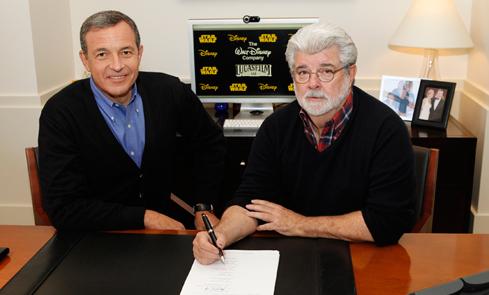
George Lucas and Bob Iger finalizing the deal to sell Lucasfilm to Disney in October 2012.
In May 2011, George Lucas met with Disney CEO Bob Iger at Walt Disney World to discuss selling Lucasfilm. Following the visit, Lucas recruited Kathleen Kennedy, former President of the Producers Guild of America, as his successor. Lucas and Kennedy started work on the Sequel trilogy and hired Michael Arndt as a screenwriter for what became Star Wars: Episode VII The Force Awakens. In June 2012, Kennedy assumed the position of co-chair of Lucasfilm.
Following Kennedy's promotion, lawyers and accountants scrutinized Lucasfilm's intellectual property in July and August 2012 to ensure that Lucas owned the rights to the characters of the Star Wars universe. After negotiations between Lucas and Iger, Lucas agreed to sell Lucasfilm in return for Disney agreeing to use his story treatments for the Sequel Trilogy in future stories. According to Iger, this was done on the understanding that Disney would not be contractually obligated to adhere to Lucas' plot lines. In addition, Iger also agreed to give Lucasfilm the same kind of limited autonomy enjoyed by Disney's other subsidiaries Pixar and Marvel. On October 30, 2012, Lucas and Iger signed an agreement selling Lucasfilm to Disney for for $4.05 billion in stock and cash. On December 21, 2012, The Walt Disney Company officially finalized its purchase of Lucasfilm.
Following the Disney acquisition, Lucasfilm underwent some restructuring and reorientation. At Kathleen Kennedy's initiative, the Lucasfilm Story Group was set up in 2012 under the leadership of Kiri Hart to coordinate the production of new Star Wars films and stories in the absence of Lucas. In 2013, Lucasfilm canceled The Clone Wars television series. Kennedy however retained the show's animation supervisor Filoni and his team, who produced a new animated television series called Star Wars Rebels. The series ran for four seasons between 2014 and 2018 and was nominated for four Emmy Awards.
In March 2014, Lucasfilm confirmed that Episode VII would be set 30 years after the events of Return of the Jedi. In addition to three new leads, Lucasfilm also confirmed that several Original Trilogy stars including Mark Hamill, Carrie Fisher, Harrison Ford, Anthony Daniels, Kenny Baker, and Peter Mayhew would reprise their roles. J.J. Abrams was recruited as director while Lawrence Kasdan replaced Arndt as screenwriter.
The Force Awakens was released on December 2015, grossing US$2 billion worldwide. Following the release of The Force Awakens, Lucasfilm produced four Star Wars cinematic films: Rogue One: A Star Wars Story (2016), Star Wars: Episode VIII The Last Jedi (2017), Solo: A Star Wars Story (2018), and Star Wars: Episode IX The Rise of Skywalker (2019). While The Force Awakens, Rogue One, and The Last Jedi performed well commercially and critically, Solo received mixed responses and underperformed at the box office. While commercially successful, Rise of Skywalker received a mixed response from critics and fans.
Besides Star Wars Rebels, Lucasfilm Animation also produced the animated shows Star Wars Forces of Destiny (2017–2018) and Star Wars Resistance (2018–2020). In addition, Lucasfilm collaborated with Disney, the LEGO Group, and Wil Film to produce several LEGO–themed Star Wars animated shows including LEGO Star Wars: The Yoda Chronicles, LEGO Star Wars: Droid Tales (2015), LEGO Star Wars: The Resistance Rises, LEGO Star Wars: The Freemaker Adventures (2017-2018), and LEGO Star Wars: All-Stars.
In September 2018, Kennedy's contract as Lucasfilm President was extended until 2021. In June 2019, Michelle Rejwan was appointed as the company's senior vice president of live-action development and production.
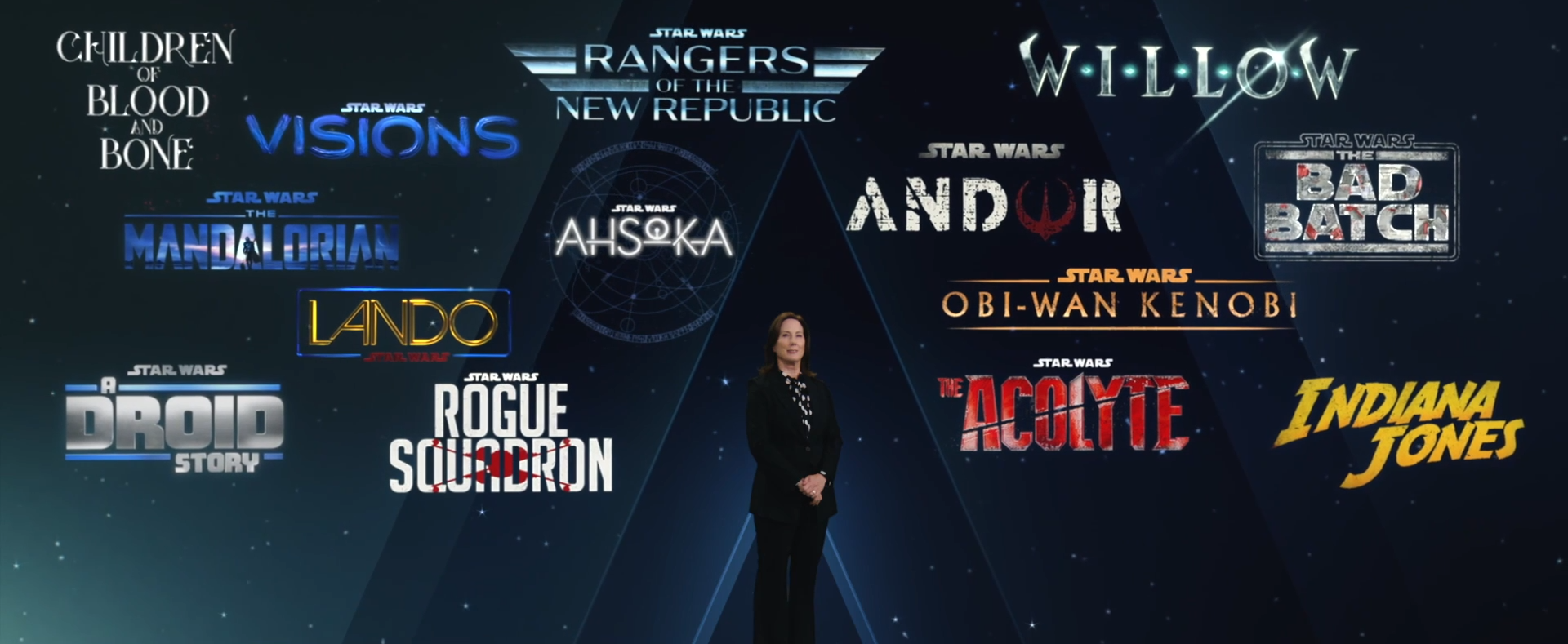
Kathleen Kennedy unveiling new Star Wars projects at the 2020 Disney Investor Day.
In October 2018, Lucasfilm also commenced production on a live-action Star Wars television series called The Mandalorian. Jon Favreau served as the series' showrunner with directors including Filoni, Deborah Chow, Rick Famuyiwa, Bryce Dallas Howard, and Taika Waititi. Airing on Disney+ on November 12, 2019, the series was well-received by both critics and fans. It was renewed for a second season, which aired on Disney+ on October 30, 2020.
In December 2020, Kennedy confirmed that Lucasfilm was working on at least ten Star Wars films and television shows including Patty Jenkins' Rogue Squadron, an untitled Taika Waititi film, several Disney+ webseries and films including Obi-Wan Kenobi, Ahsoka, Rangers of the New Republic, a Lando Calrissian series, Andor, The Acolyte, the animated Star Wars: The Bad Batch series, the anime Star Wars: Visions, and A Droid Story. In addition, Kennedy confirmed that the company was also working on at least two non-Star Wars projects including a sequel to the 1988 fantasy film Willow and an adaptation of Tomi Adeyemi's young adult novel Children of Blood and Bone.
In September 2022, Lucasfilm confirmed that it was working on several new productions including the animated series Star Wars: Tales of the Jedi, Star Wars: Young Jedi Adventures, and the live-action series Star Wars: Skeleton Crew. In addition, the company confirmed the release dates for its Willow TV series and a fifth Indiana Jones film.
In April 2023, Kennedy confirmed at Celebration Europe that the studio was working on three live-action films directed by James Mangold, Dave Filoni, and Sharmeen Obaid-Chinoy. Mangold's film will explore the dawn of the Jedi Order while Filoni's film will be set in the New Republic era and connect several Disney+ shows including The Mandalorian, The Book of Boba Fett, and Ahsoka. Obaid-Chinoy's film will be set after the events of The Rise of Skywalker with Daisy Ridley reprising her role as Rey Skywalker. In addition, Lucasfilm confirmed the release dates for Ahsoka and The Acolyte in August 2023 and 2024 respectively.

The High Republic multimedia publishing project
In February 2013, the LucasArts division was dissolved, leading to the layoff of 200 employees. Ten employees remained to coordinate the production of licensed Star Wars computer games.
In May 2013, Lucasfilm and Disney Interactive signed a multi-year, multi-title exclusive contract with Electronic Arts to produce Star Wars computer games. While EA would focus on high quality products, Disney Interactive retained the rights to produce games for more "casual audiences". Notable Star Wars games published under the EA license have included Star Wars Battlefront (2015),Star Wars Battlefront II (2017), Star Wars Jedi: Fallen Order, and Star Wars: Squadrons (2020).
In January 2014, Lucasfilm granted Marvel Comics the exclusive rights to produce new Star Wars comics from 2015. On April 25, 2014, the Lucasfilm Story Group clarified that only Lucas' six Star Wars films and The Clone Wars television series were Canon. The Expanded Universe was reclassified as Star Wars Legends and would be used as resources for future stories. All subsequent Star Wars literature and media would be part of a single, cohesive continuity. Shortly after Lucasfilm's Canon reboot, Disney Publishing Worldwide announced that Del Rey would be publishing a new line of Canon Star Wars novels on a bi-monthly schedule, commencing with John Jackson Miller's 2014 novel A New Dawn.
In April 2017, IDW Publishing acquired a license from Lucasfilm to produce all-ages Star Wars comics, commencing with Star Wars Adventures.
In February 2020, Lucasfilm unveiled a new multimedia publishing project called Star Wars: The High Republic, which is set 200 years before the events of The Phantom Menace. Key authors associated with the project included Claudia Gray, Daniel José Older, Charles Soule, Cavan Scott, and Justina Ireland. The High Republic involved several publishers, including Del Rey, Disney–Lucasfilm Press, IDW Publishing, and Marvel Comics.
In January 2021, Lucasfilm revealed a new video game division called Lucasfilm Games to provide support to the company's licensed publishers and developers. That same month, Lucasfilm Games entered into partnerships with publishers Ubisoft and Bethesda Softworks to produce new Star Wars and Indian Jones computer games. In February 2021, Lucasfilm Games confirmed that it was working with games developer Zynga to produce a competitive arena combat game called Star Wars: Hunters.
In November 2021, Dark Horse Comics announced that it would be collaborating with Lucasfilm and Disney Publishing Worldwide to produce a new line of all-age comics and graphic novels stretching from the High Republic to the First Order era.
Lucasfilm was reorganized to consolidate all the companies to be under Lucasfilm. Today, Lucasfilm is made up of six divisions:
- Lucasfilm – film and television production and promotion
- Lucas Digital – company composed of Industrial Light & Magic (ILM) and Skywalker Sound. This company may not exist any longer since the Walt Disney Company reorganization.
- Lucasfilm Animation and Lucasfilm Animation Singapore – digital animation studio for film, television, and games
- Lucasfilm Games is a division of Lucasfilm dedicated to providing support to partners video game publishers and developers.
- Lucas Licensing – licensing and merchandising for Star Wars, Indiana Jones, and other Lucasfilm projects
- Lucas Online – online destination for entertainment, reference, education, and e-commerce for Lucasfilm projects
A few other companies started out under the Lucasfilm umbrella:
- LucasArts – developer and publisher of interactive entertainment software. The company was eventually reorganized in a licensing model following the Walt Disney Company's acquisition of Lucasfilm.
- Black Falcon – handled merchandising for Lucasfilm briefly before fully merging into Lucasfilm in December 1979
- Pixar – computer animation film-production company (sold to Steve Jobs in 1986)
- THX – theater sound system (spun off from Lucasfilm in 2002)
- Star Wars Corporation – started separately in 1973 and absorbed into Lucasfilm by 1980
- Kathleen Kennedy: President
- Lynwen Brennan: Executive Vice President and General Manager
- Momita SenGupta: Executive Vice President, Physical Production
- : Senior Vice President, Chief Creative Officer, Industry Light & Magic (ILM)
- Rhonda Hjort: Senior Vice President, business affairs & legal counsel
- Janet Lewin: Senior Vice President, ILM
- Michelle Rejwan: Senior Vice President, Life Action Development & Production
- : Senior Vice President, licensing
- Pippa Anderson: Vice President, post-production
- Lori Aultman: Vice President, finance & planning
- Carrie Beck: Vice President, animation & life action series development
- : Executive in charge, ILMxLAB
- Candice Campos: Vice President, physical production
- : Senior director, online content & programming
- Blaire Chaput: Vice President, human resources
- : Vice President, technology
- Doug Chiang: Vice President & Executive Creative Director, Star Wars
- Joseph Cho: Vice President, production finance
- Megan Crumpacker: Vice President, franchise marketing & integrated planning
- : Vice President, live action series development
- Lynne Hale: Vice President, publicity & communications
- John Hampian: Vice President, physical production
- Kensie Kim: Vice President, business affairs & legal counsel
- John Knoll: Executive creative director, senior visual effects supervisor, ILM
- Jacqui Lopez: Vice President, franchise production
- Josh Lowden: Vice President & General Manager, Skywalker Sound
- Athena Yvette Portillo: Vice President, animation production
- Douglas Reilly: Lucasfilm Games
- Rayne Roberts: Vice President, film development
- Max Taylor: Vice President, film development
- James Waugh: Vice President, franchise content & strategy
- Raymond Wu: Vice President, business affairs & legal counsel
- Anna Yeager: Vice President, marketing and franchise creative